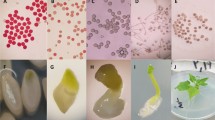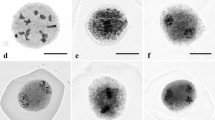Abstract
Triploid tulips have agronomically desirable traits such as vigorous growth and large flower size, but only a portion of all cultivated tulips is triploid. To apply 2n pollen to polyploid breeding of tulips, the polyploidizing agent, nitrous oxide gas (N2O), was applied to bulbs. In tulips, meiosis in anthers occurs inside the bulbs from mid- to late-October. When meiosis in anthers (excised from bulbs) reached metaphase I, we treated other bulbs of the same clones with N2O for 24–48 h. Most of the treated plants produced pollen grains with a wide-ranging or bimodal size distribution, indicating a mixture of n, 2n and aneuploid pollen grains. The use of pollen containing a relatively high proportion of giant pollen grains tended to yield larger numbers of triploids in the progeny. The number of giant pollen grains could be increased when N2O-treated pollen grains were suspended in 10% sucrose and then sieved through a nylon mesh. Very few polyploids were observed in some cross combinations, even those involving pollen with a relatively high proportion of giant grains. Even so, this low polyploid yield most likely is due to a triploid block, because the capsules obtained in the crosses of the diploid×N2O-treated plants contained some abnormal seeds, which were mostly triploid. Embryo culture was useful in rescuing abnormal embryos. The present study reveals that 2n pollen can be produced at high frequency using N2O during tulip breeding.
Similar content being viewed by others
Abbreviations
- PMC:
-
Pollen mother cell
References
Anonymous, 1968. Kruisingsouderslijst tulpen. Koninklijke Algemeene Vereeniging voor Bloembollencultuur (KAVB). Haarlem.
Asano, Y., 1984. Fertility of a hybrid between distantly related species in Lilium. Cytologia 49: 447–456.
Berdahl, J.D. & R.E. Barker, 1991. Characterization of autotetraploid Russian wildrye produced with nitrous oxide. Crop Sci 31: 1153–1155.
Bino, R.J., J.M. Van Tuyl & J.N. De Vries, 1990. Flow cytometric determination of relative nuclear DNA contents in bicellulate and tricellulate pollen. Annals Bot 65: 3–8.
Bretagnolle, F. & J.D. Thompson, 1995. Gametes with the somatic chromosome number: mechanisms of their formation and role in the evolution of autopolyploid plants. New Phytol 129: 1–22.
Bullitta, S., G.M. Scarpa, R.R. Smith & F. Veronesi, 1995. Unreduced gametes in ball clover and its relevance in white clover breeding. J Genet Breed 49: 157–162.
De Mol, W.E., 1928. The origin of diploid and tetraploid pollen grains in Duc van Thol tulips (Tulipa suaveolens) dependent of the method of culture applied. Genetica 11: 119–212.
Dvorak, J. & B.L. Harvey, 1973. Production of aneuploids in Avena sativa L. by nitrous oxide. Can J Genet Cytol 15: 649–651.
Dvorak, J., B.L. Harvey & B.E. Coulman, 1973. The use of nitrous oxide for producing euploids and aneuploids in wheat and barley. Can J Genet Cytol 15: 205–214.
Falistocco, E., M.E. Caceres & M. Falcinelli, 1994. Meiotic mechanisms of 2n pollen formation in Dactylis glomerata subsp. lusitanica. J Genet Breed 48: 41–46.
Filotico, F., D. Carputo & A. Barone, 1995. 2n pollen production in Solanum phureja × S. tuberosum hybrids. J. Genet Breed 49: 255–260.
Hanneman, R.E. & S.J. Peloquin, 1968. Ploidy levels of progeny from diploid-tetraploid crosses in the potato. Am potato J 45: 255–261.
Iizuka, M. & A. Ikeda, 1968. Induction of polyploidy in Lilium formosanum Wallace. Jpn J Genet 43: 95–101.
Johnston, S.A., T.P.M. den Nijs, S.J. Peloquin & R.E. Hanneman Jr., 1980. The significance of genic balance to endosperm development in interspecific crosses. Theor Appl Genet 57: 5–9.
Kato, A., 1997. An improved method for chromosome counting in maize. Biotech Histochem 72: 249–252.
Kato, A., 2002. Chromosome doubling of haploid maize seedling using nitrous oxide gas at the flower primordial stage. Plant Breed 121: 370–377.
Kihara, H. & I. Nishiyama, 1932. Different compatibility in reciprocal crosses of Avena, with special reference to tetraploid hybrids between hexaploid and diploid species. Jpn J Botany 6: 245–305.
Kihara, H. & K. Tsunewaki, 1960. Production of polyploid wheat by nitrous oxide. Proc Jpn Acad Sci 36: 658–663.
Killingback, S. 1990. Tulips. Chartwell Books, INC.
Kroon, G.H. & J.P. van Eijk, 1977. Polyploidy in tulips (Tulipa L.). The occurrence of diploid gametes. Euphytica 26: 63–66.
Lim, K.B., M.S. Ramanna, J.H. De Jong, E. Jacobsen & J.M. Van Tuyl, 2001. Indetermine meiotic restitution (IMR): A novel type of meiotic nuclear restitution detected interspecific lily hybrids by GISH. Theor Appl Genet 103: 219–230.
Lim, K.B., M.S. Ramanna, J.H. De Jong, E. Jacobsen & J.M. Van Tuyl, 2003. Evaluation of BC2 progenies derived from 3x-2x and 3x-4x crosses of Lilium hybrids: A GISH analysis. Theor Appl Genet 106: 568–574.
Maceira, N.O., A.A. De Haan, R. Lumaret, M. Billon & J. Delay, 1992. Production of 2n gametes in diploid subspecies of Dactylis glomerata L. 1. Occurrence and frequency of 2n pollen. Annals of Bot 69: 335–343.
McHale, N.A., 1983. Environmental induction of high frequency 2n pollen formation in diploid Solanum. Can J Genet Cytol 25: 609–615.
Murashige, T. & F. Skoog, 1962. A revised medium for rapid growth and bioassasys with tabacco tissue culture. Physiol Plant 15: 473–497.
Nishiyama, I. & N. Inomata, 1966. Embryological studies on cross incompatibility between 2x and 4x in Brassica. Jpn J Genet 41: 27–42.
Nygren, A., 1955. Polyploids in Melandrium produced by nitrous oxide. Hereditas 41: 287–290.
Okazaki, K. & M. Nishimura, 2000. Ploidy of progenies crossed between diploids, triploids and tetraploids in tulip. Acta Hortic 522: 127–134.
Orjeda, G., R. Freyre & M. Iwanaga, 1990. Production of 2n pollen in diploid Ipomoea trifida, a putative wild ancestor of Sweet Potato. J Heredity 81: 462–467.
Östergren, G., 1954. Polyploids and aneuploids of Crepis capillaris produced by treatment with nitrous oxide. Genetica 27: 54–64.
Östergren, G., 1957. Production of polyploids and aneuploids of Phalaris by means of nitrous oxide. Hereditas 43: 512–516.
Parrott, W.A. & R.R. Smith, 1984. Production of 2n pollen in red clover. Crop Sci 24: 469–472.
Ramanna, M.S., 1979. A re-examination of the mechanisms of 2n gametes formation in potato and its implications for breeding. Euphytica 28: 537–561.
Ramanna, M.S., A.G.J. Kuipers & E. Jacobsen, 2003. Occurrence of numerically unreduced (2n) gametes in Alstroemeria interspecific hybrids and their significance for sexual polyploidisation. Euphytica 133: 95–106.
Sala, C.A., E.L. Camadro, M.T. Salaberry, & A.O. Mendiburu, 1989. Cytological mechanism of 2n pollen formation and unilateral sexual polyploidization in Lolium. Euphytica 43: 1–6.
Shisa, M., 1955. Study on exported tulip bulbs. Seibundo-shikousha Tokyo, pp. 1–29.
Straathof, T.P. & W. Eikelboom, 1997. Tulip breeding at PRI. Daffidil and Tulip Yearbook 1997-8: 27–33.
Taylor, N.L., M.K. Anderson, K.H. Quesenbery & L. Watson, 1976. Doubling the chromosome number of Trifolium species using nitrous oxide. Crop Sci 16: 516–518.
Upcott, M. & L. La Cour, 1936. Genetic structure of Tulipa. I. A chromosome survey. J Genet 33: 237–257.
Van Raamsdonk, L.W.D. & T. De Vries, 1995. Species relationships and taxonomy in Tulipa subg. Tulip (Liliaceae). Plant Syst Evol 179: 27–41.
Van Santen, E., P.M. Hugessen & M.D. Casler, 1991. Identification and frequency of tetraploid progeny from 2x-4x and 4x-2x crosses in Dactylis. Genome 34: 273–278.
Van Scheepen, J., 1996. Classified list and international register of tulip names. General Bulbgrowers’ Association, Holland.
Van Tuyl, J.M. & P.B. Stekelenburg, 1988. Genotypic and environmental variation in production of 2n-gametes in Lilium. In: M. Cresti, P. Gori & E. Pacini (Eds.), Sexual Reproduction of Higher Plants, pp. 486. Springer Verlag, Berlin.
Van Tuyl, J.M., J.M. De Vries, R.J. Bino & T.A.M. Kwakkenbos, 1989. Identification of 2n-pollen producing interspecific hybrids of Lilium by flow cytometry. Cytologia 54: 737–745.
Van Tuyl, J.M., B. Meijer & M.P. van Diën, 1992 The use of oryzalin as an alternative for colchicine in in-vitro chromosome doubling of Lilium and Nerine. Acta Hortic 352: 625–630.
Veilleux, R.E., N.A. Mchale & F.I. Lauer, 1982. 2n gametes in diploid Solanum: Frequency and types of spindle abnormalities. Can J Genet Cytol 24: 301–314.
Veronesi, F. A. Mariani & E.T. Bingham, 1986. Unreduced gametes in diploid Medicago and their importance in alfalfa breeding. Theor Appl Genet 72: 37–41.
Zeilinga, A.E. & H.P. Schouten, 1968a. Polyploidy in garden tulips. I. Survey of Tulipa varieties for polyploids. Euphytica 17: 252–264.
Zeilinga, A.E. & H.P. Schouten, 1968b. Polyploidy in garden tulips. II. Polyploidy in Garden tulips. II. The production of tetraploids. Euphytica 17: 303–310.
Author information
Authors and Affiliations
Corresponding author
Rights and permissions
About this article
Cite this article
Okazaki, K., Kurimoto, K., Miyajima, I. et al. Induction of 2n pollen in tulips by arresting the meiotic process with nitrous oxide gas. Euphytica 143, 101–114 (2005). https://doi.org/10.1007/s10681-005-2910-7
Received:
Accepted:
Issue Date:
DOI: https://doi.org/10.1007/s10681-005-2910-7




